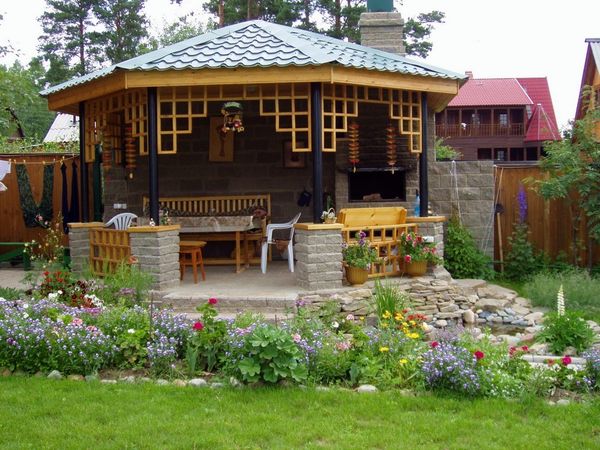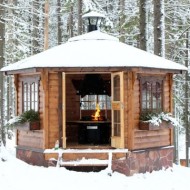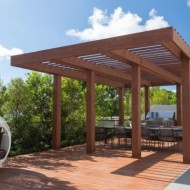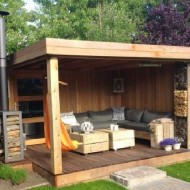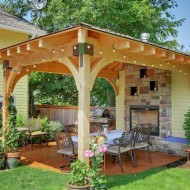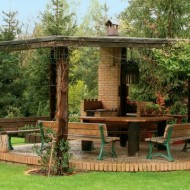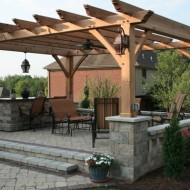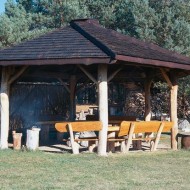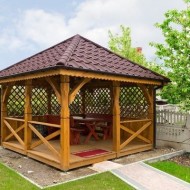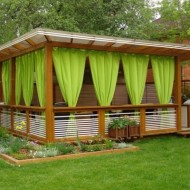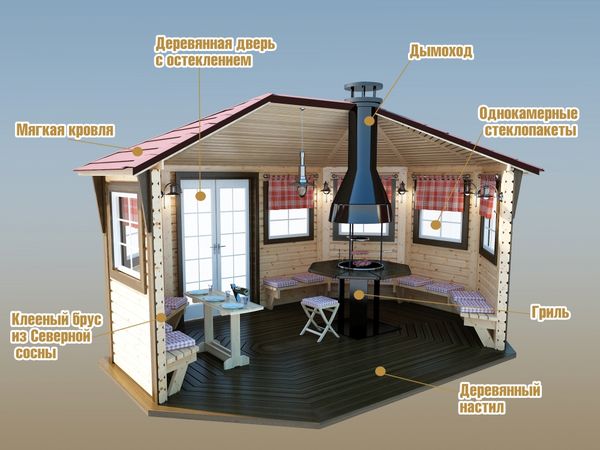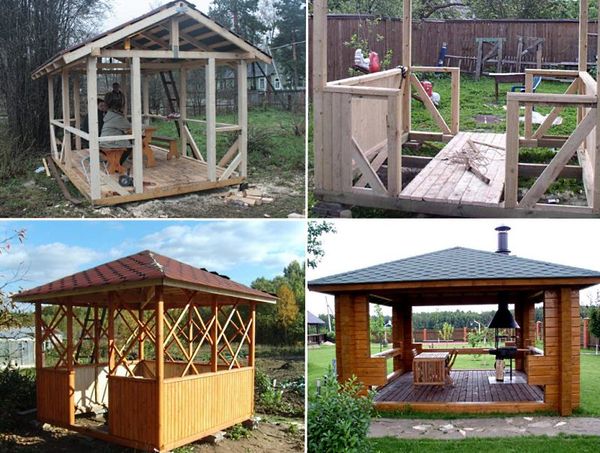The best ideas for building gazebos for summer cottages from experienced designers
Content
Typical classification
There are different types of buildings: closed and open structures, partially or completely glazed, in austere style or ornate carved.
There are also stationary and mobile gazebos. Stationary designs are made of cement, brick, wood, steel. They are designed for year-round use. Summer mobile structures are installed as needed for use and when weather conditions permit. Stationary options can be divided into indoor and outdoor, detached or adjacent to the house.
Modern closed-type summer cottages have a foundation and a floor, open structures can also be built with a foundation and a floor, but they are not protected from external influences. Sometimes gazebos are an extension of the house. The adjoining structure can also be closed and open, but it is built in the same architectural style as the main building.
Portable lightweight options are very convenient, they are easy to assemble, disassemble and install in any suitable place. They can be conditionally divided into types, based on the building materials from which they are made.
Video "Building a gazebo in one day"
From this video you will learn how to build a beautiful gazebo with your own hands in one day.
Popular forms
Most often there are summer cottages:
- in the form of an oval or circle;
- structures in the shape of a square and a rectangle;
- original structures in the form of a hexagon or octahedron;
- interesting options of irregular shape with sharp corners and smooth curves.
By purpose and size, the following varieties are distinguished:
- gazebos with solid walls with ceilings;
- buildings for organizing feasts with sets of garden furniture;
- street gazebos, which are almost a full-fledged kitchen due to the presence of built-in fireplaces, barbecue.
There are even exclusive options with a Russian stove to create a special atmosphere.
Separation by material
A huge variety of materials for construction helps to embody ideas for income of any level and style of construction. Building materials can be roughly classified into typical and unusual.
Traditional materials:
- Stone, brick. Resistant to rain, snow, insects, durable and durable.
- Various types of wood: boards, beams.
- Elite metal models are distinguished by an exclusive design, long service life, but costly on a budget.
Stylish and creative models of gazebos can be built from unusual building materials. Materials can be very diverse:
- Glass or plastic bottles. For the construction of the structure, a foundation is being built, a metal profile serves as a frame. The design looks very creative.
- Concrete mortar using monolithic construction techniques. The roof is made of plexiglass or plastic. This design is ideal for a high-tech or minimalist architectural ensemble.
- Natural plants. The frame in the construction of such a gazebo is wooden or metal supports braided by climbing plants.
- Natural materials such as vines or reeds. Beautiful wicker gazebos will become a real decoration of the landscape, especially against the backdrop of a reservoir.
Often there are combined types of gazebos with the use of various building materials. Their choice depends on at what time and for what purpose the gazebo will be used.
Functional features
If a decision is made to install a barbecue in the gazebo in order to fry a barbecue in nature, then the design should be as safe and reliable as possible. For this, a foundation is being erected with the installation of additional supports for a barbecue, a stove. It is better to build walls of brick or timber. It is imperative to carry out fire-prevention treatment beforehand. You can choose any shape of the barbecue, but there should be small sides along the edges to support the main frame.
It is important to consider that a building with an open source of fire is designed in strict accordance with fire regulations.
There should be at least three meters of free space in front of the barbecue, and more than one meter on the sides. It is desirable that the wall adjacent to the fire source be protected with a cement slab. The floor under the barbecue is covered with a sheet of iron. If the floor is made of stone, no additional protection is required.
Design techniques
The interior arrangement of the gazebo depends on the designer's intention and the functional purpose of the building. If a brazier with a stationary structure is provided, then the octagonal shape of the structure is suitable, along the perimeter of which you can place benches. For additional comfort, you can divide the space into functional zones, beautifully decorate them with lighting. You can build a mini-bar inside the gazebo.
Common styles
The architectural styles of the gazebos are endlessly varied. Let's consider the most popular ones:
- The contemporary style combines natural and artificial materials, including glass and ceramics. With this design, a large number of green plants are present in the interior, a lot of attention is paid to the zoning of the room. Such buildings usually have a place for cooking and equipped with a dining area.
- Forged gazebos are often made in the Art Nouveau style. Here you can see many curved lines, floral curls, turning into the supporting elements of the structure.
- The chalet style evokes the atmosphere of the snowy Alps. For the construction of such gazebos, natural materials are used, mainly stone and wood. The interior is dominated by calm, natural colors. For decoration, you can use deer antlers, dried wildflowers, carved wood products.
- The Japanese style has become very popular with garden owners over the past decades. A characteristic feature of gazebos in this style is a roof, consisting of several tiers, or a pagoda. The design is minimalist, and the roof, on the contrary, is made spectacular, with raised corners to achieve the effect of a floating, airy structure.
Decorating
With the help of the decor inside the gazebo, you can create a special atmosphere. But the choice of decoration elements depends only on individual preferences.
Even the simplest laconic design can be turned into an elite class, if you supplement it with a floor made of natural stone or tiles, arrange wicker furniture beautifully, correctly arrange lighting, add upholstered furniture with textile elements to the fireplace area.
The solid wood will look more elegant if the roof is built from tiles, and the railings are supplemented with openwork metal forging.
To decorate the interiors of gazebos in the country or a country house, it is recommended to choose textiles in bright colors, and light furniture. Fresh flowers will be a beautiful addition. Furniture made from natural materials - rattan or vines - will be an ideal complement to the gazebo.
Construction stages
Before starting construction, it is necessary to prepare the selected area, remove debris, irregularities and all unnecessary. Next, you have to decide on the size of the gazebo and make a drawing. On the drawing, you need to indicate the place of pouring the foundation, then make a pit of the appropriate size and install the formwork.
At the next stage, we install vertical structures and floor beams. Vertical structures and pre-prepared logs must be connected and closed with boards for flooring. Wood structures are recommended to be primed and then painted. It is better to choose colors for paint in calm, warm shades so that the gazebo most harmoniously fits into the natural landscape.
The roof for the gazebo can be different, in accordance with the chosen architectural concept. The main thing is to provide for the correct outflow of rainwater.
At the final stage - the beautification of the gazebo: the design of the barbecue, the installation of furniture and decorative elements. You can put beautiful bright pillows on wooden benches, and scented candles in exquisite candlesticks on the tables. The walls of the gazebo can be decorated with light light tulle or special decorative awnings.
Particular attention should be paid to the gardening of the gazebo. Ampelous plants suspended in pots look beautiful, as well as spectacular exotic plants in tall ceramic vases.

